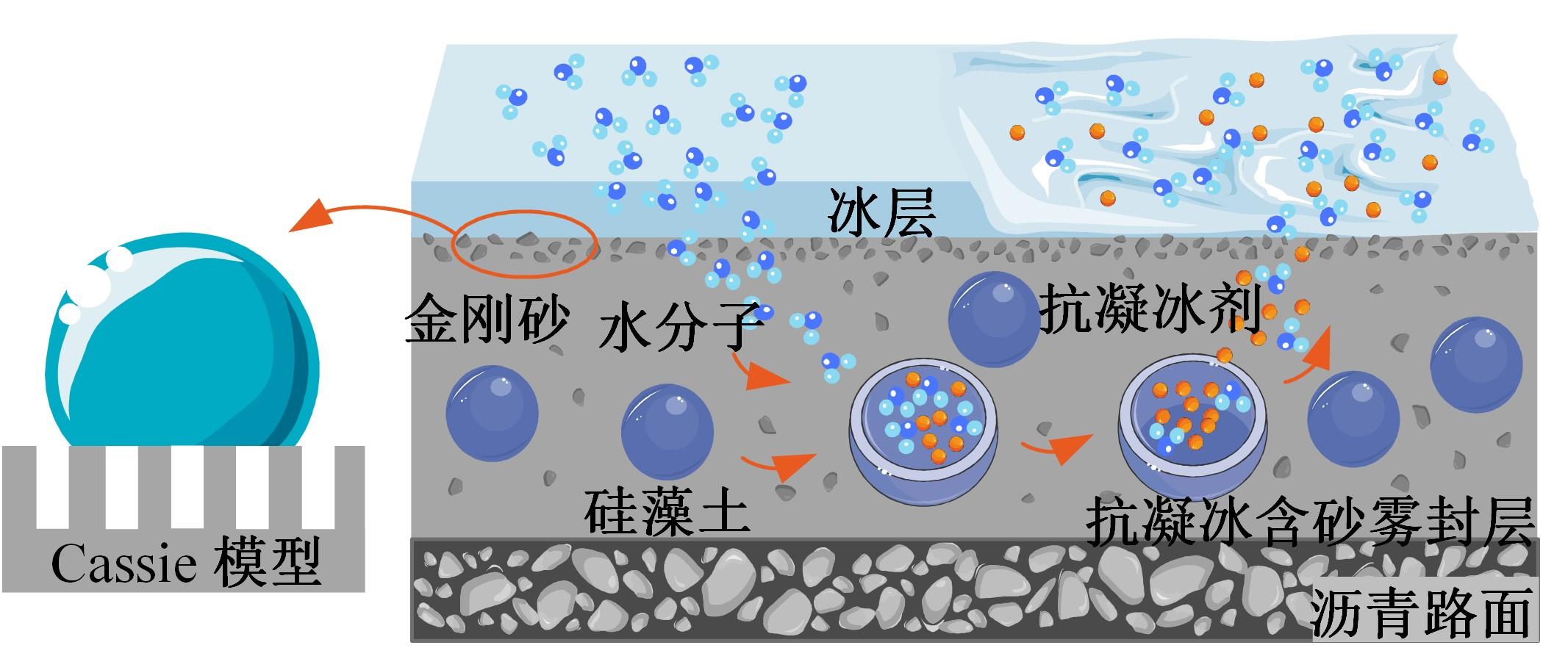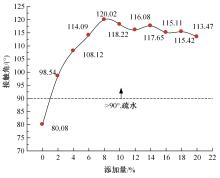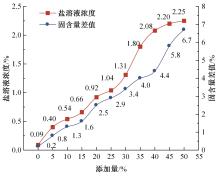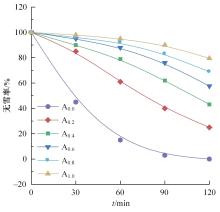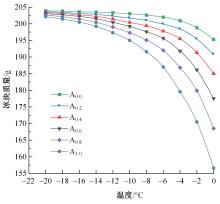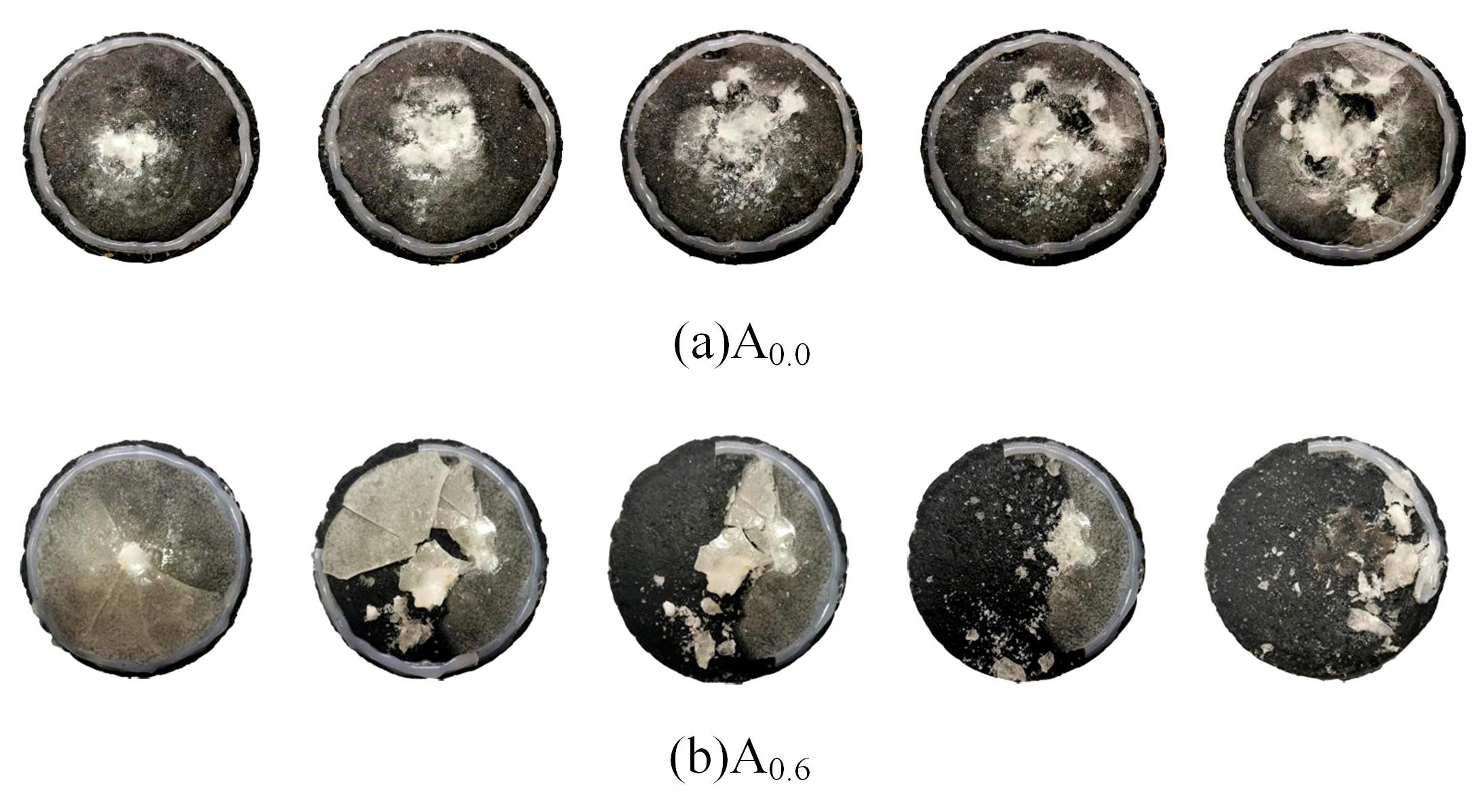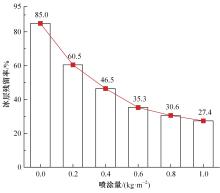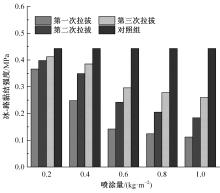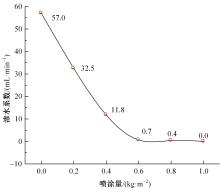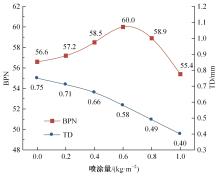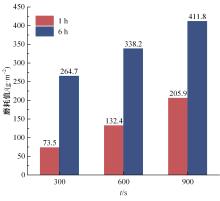Journal of Jilin University(Engineering and Technology Edition) ›› 2023, Vol. 53 ›› Issue (12): 3492-3500.doi: 10.13229/j.cnki.jdxbgxb.20220089
Preparation and properties analysis of antifreeze sand fog seal
Zheng-qi ZHANG1( ),Chang LU1,Ya-kui QIANG1,2,Yin-chuan GUO1,dong WANG3,Fu-qiang ZHAO3
),Chang LU1,Ya-kui QIANG1,2,Yin-chuan GUO1,dong WANG3,Fu-qiang ZHAO3
- 1.Key Laboratory for Special Area Highway Engineering of Ministry of Education,Chang'an University,Xi'an 710064,China
2.Transportation Bureau of Jiuquan,Jiuquan 735000,China
3.Shaanxi Transportation Holdings Group Co. ,Ltd. ,Xi'an 710009,China
CLC Number:
- U416.217
| 1 | 姚运仕, 陈团结, 向豪, 等. 环保型长效自融冰雪路面涂层试验[J]. 交通运输工程学报, 2013, 13(4): 8-15. |
| Yao Yun-shi, Chen Tuan-jie, Xiang Hao, et al. Experiment of active deicing and snow melting pavement coating with environmental friendly and long-term action[J]. Journal of Traffic and Transportation Engineering, 2013, 13(4): 8-15. | |
| 2 | 高英力, 代凯明, 黄亮, 等. 超疏水-防覆冰技术在公路路面中的研究应用进展[J]. 材料导报, 2017, 31(1): 103-109. |
| Gao Ying-li, Dai Kai-ming, Huang Liang, et al. Research and application of superhydrophobic and anti-icing technology in highway pavement[J]. Materials Review, 2017, 31(1): 103-109. | |
| 3 | 陈渊召, 李振霞, 赵晨奥, 等. 环保缓释型主动融冰雪涂层材料研究[J]. 中国公路学报, 2020, 33(9): 155-167. |
| Chen Yuan-zhao, Li Zhen-xia, Zhao Chen-ao, et al. Coating material for environmental sustained release active melting of ice and snow[J]. China Journal of Highway and Transport, 2020, 33(9): 155-167. | |
| 4 | 刘状壮, 张有为, 季鹏宇,等.电热型融雪沥青路面传热特性研究[J].吉林大学学报: 工学版, 2023, 53(2): 523-530. |
| Liu Zhuang-zhuang, Zhang You-wei, Ji Peng-yu, et al. Study on heat transfer characteristics of electric heating snow melting asphalt pavement[J]. Journal of Jilin University (Engineering and Technology Edition), 2023, 53(2): 523-530. | |
| 5 | 李君, 矫维成, 王寅春, 等. 超疏水材料在防/除冰技术中的应用研究进展[J]. 复合材料学报, 2022, 39(1): 23-38. |
| Li Jun, Jiao Wei-cheng, Wang Yin-chun, et al. Research progress on application of superhydrophobic materials in anti-icing and de-icing technology[J]. Acta Materiae Compositae Sinica, 2022, 39(1): 23-38. | |
| 6 | 雷俊安, 郑南翔, 陈朝阳. 抑冰融雪涂层的制备与性能研究[J]. 公路, 2019, 64(5): 256-261. |
| Lei Jun-an, Zheng Nan-xiang, Chen Chao-yang. Preparation and research on performance of ice-snow melting coating[J]. Highway, 2019, 64(5): 256-261. | |
| 7 | 吉增晖, 俞春荣, 高志明. 含砂雾封层性能评价与工程应用研究[J]. 公路, 2017, 62(2): 205-210. |
| Ji Zeng-hui, Yu Chun-rong, Gao Zhi-ming. Study on performance evaluation and engineering application of sand fog seal[J]. Highway, 2017, 62(2): 205-210. | |
| 8 | Hu C H, Li R, Zhao J Y, et al. Performance of waterborne epoxy emulsion sand fog seal as a preventive pavement maintenance method: from laboratory to field[J]. Advances in Materials Science and Engineering, 2020, 2020: No. 6425817. |
| 9 | Guo T T, Wang C H, Yang X, et al. Development and performance of sand fog seal with cooling and air purification effects[J]. Construction and Building Materials, 2017, 141: 608-618. |
| 10 | 冯炜, 韩晓霞, 王帅, 等. 降温含砂雾封层最佳喷洒量[J]. 筑路机械与施工机械化, 2017, 34(6): 33-36. |
| Feng Wei, Han Xiao-xia, Wang Shuai, et al. Optimum spray amount of cooling fog seal with sand[J]. Road Machinery & Construction Mechanization, 2017, 34(6): 33-36. | |
| 11 | 张倩, 张旭景, 徐义恒. 水性环氧-SBR改性乳化沥青粘结料界面力学性质分析[J]. 材料科学与工程学报, 2021, 39(3): 366-372. |
| Zhang Qian, Zhang Xu-jing, Xu Yi-heng. Mechanical property analysis of waterborne epoxy-SBR modified emusified asphalt binder[J]. Journal of Materials Science and Engineering, 2021, 39(3): 366-372. | |
| 12 | 胡富贵, 田小革, 胡宏立, 等. SBR胶乳掺量对改性乳化沥青性能的影响[J]. 建筑材料学报, 2021, 24(4): 895-900. |
| Hu Fu-gui, Tian Xiao-ge, Hu Hong-li, et al. Effect of SBR latex content on performance of modified emulsified asphalt[J]. Journal of Building Materials, 2021, 24(4): 895-900. | |
| 13 | 孙吉书, 侯坤, 王鹏飞. 表面有机化硅藻土-胶粉复合改性沥青性能研究[J]. 热固性树脂, 2021, 36(5): 15-20. |
| Sun Ji-shu, Hou Kun, Wang Peng-fei. Study on the performance of surface organic diatomite-crumb rubber composite modified asphalt[J]. Thermosetting Resin, 2021, 36(5): 15-20. | |
| 14 | Zheng L, Wu X, Lou Z, et al. Superhydrophobicity from microstructured surface[J]. Chinese Science Bulletin, 2004, 49(17): 1779-1787. |
| 15 | Milne A, Elliott J, Zabeti P, et al. Model and experimental studies for contact angles of surfactant solutions on rough and smooth hydrophobic surfaces[J]. Physical Chemistry Chemical Physics Pccp, 2011, 13(36): 16208-16219. |
| 16 | 唐斯. 水泥乳化沥青砂浆的吸水和失水特性及干湿循环对性能的影响[D]. 长沙: 中南大学土木工程学院, 2014. |
| Tang Si. Water absorption and evaporating characteristics of cement asphalt mortar and effect of wetting-drying cycles on its properties[D]. Changsha: College of Civil Engineering, Central South University, 2014. | |
| 17 | 邬惠娟, 徐刚. 含砂雾封层技术设计及应用[J].公路交通科技: 应用技术版, 2015, 11(6): 130-131. |
| Wu Hui-juan, Xu Gang. Design and application of sand fog seal technology[J]. Highway Traffic Technology (Application Technology Edition), 2015, 11(6): 130-131. | |
| 18 | EN 12272-3-2003. Surface dressing-test method-part 3: determination of binderaggregate adhesivity by the vialit plate shock test method [S]. |
| 19 | . 环氧树脂地面涂层材料 [S]. |
| [1] | Sheng-qian ZHAO,Zhuo-hong CONG,Qing-long YOU,Yuan LI. Adhesion and raveling property between asphalt and aggregate: a review [J]. Journal of Jilin University(Engineering and Technology Edition), 2023, 53(9): 2437-2464. |
| [2] | Tao MA,Yuan MA,Xiao-ming HUANG. Optimal combination of key parameters of intelligent compaction based on multiple nonlinear regression [J]. Journal of Jilin University(Engineering and Technology Edition), 2023, 53(7): 2067-2077. |
| [3] | Liu YANG,Chuang-ye WANG,Meng-yan WANG,Yang CHENG. Traffic flow characteristics of six⁃lane freeways with a dedicated lane for automatic cars [J]. Journal of Jilin University(Engineering and Technology Edition), 2023, 53(7): 2043-2052. |
| [4] | Zheng-feng ZHOU,Xiao-tao YU,Ya-le TAO,Mao ZHENG,Chuan-qi YAN. High-temperature performance evaluation of resin and elastomer high viscosity asphalt based on grey correlation analysis [J]. Journal of Jilin University(Engineering and Technology Edition), 2023, 53(7): 2078-2088. |
| [5] | Qing-xia ZHANG,Ji-lin HOU,Xin-hao AN,Xiao-yang HU,Zhong-dong DUAN. Road roughness identification method based on vehicle impulse response [J]. Journal of Jilin University(Engineering and Technology Edition), 2023, 53(6): 1765-1772. |
| [6] | Ping JIANG,Ye-wen CHEN,Xian-hua CHEN,Wei-qing ZHANG,Na LI,Wei WANG. Unconfined compression behavior of modified lime stabilized soil under dry wet and freeze⁃thaw cycles [J]. Journal of Jilin University(Engineering and Technology Edition), 2023, 53(6): 1809-1818. |
| [7] | Chun-di SI,Ya-ning CUI,Zhong-yin XU,Tao-tao FAN. Meso⁃mechanical behavior analysis of asphalt bridge deck pavement after interlayer bonding failure [J]. Journal of Jilin University(Engineering and Technology Edition), 2023, 53(6): 1719-1728. |
| [8] | Yan LI,Jiu-peng ZHANG,Zi-xuan CHEN,Guo-jing HUANG,Pei WANG. Evaluation of asphalt pavement performance based on PCA⁃PSO⁃SVM [J]. Journal of Jilin University(Engineering and Technology Edition), 2023, 53(6): 1729-1735. |
| [9] | Xiao-kang ZHAO,Zhe HU,Jiu-peng ZHANG,Jian-zhong PEI,Ning SHI. Research progress in intelligent monitoring of pavement icing based on optical fiber sensing technology [J]. Journal of Jilin University(Engineering and Technology Edition), 2023, 53(6): 1566-1579. |
| [10] | Bing HUI,Xin-yi YANG,Le-yang ZHANG,Yang LI. Influence of detecting track offset on calculation error of asphalt pavement wearing [J]. Journal of Jilin University(Engineering and Technology Edition), 2023, 53(6): 1756-1764. |
| [11] | Jue LI,An-shun ZHANG,Jun-hui ZHANG,Jun-feng QIAN. Model testing and numerical analysis of dynamic response of graded crushed rock base structure [J]. Journal of Jilin University(Engineering and Technology Edition), 2023, 53(6): 1782-1789. |
| [12] | Bo LI,Xin LI,Hong RUI,Yuan LIANG. Displacement prediction of tunnel entrance slope based on variational modal decomposition and grey wolf optimized extreme learning machine [J]. Journal of Jilin University(Engineering and Technology Edition), 2023, 53(6): 1853-1860. |
| [13] | Zhuang-zhuang LIU,Wen-qing ZHENG,Jian ZHENG,Yi-zheng LI,Peng-yu JI,Ai-min SHA. Pavement surface temperature monitoring method based on gridding approach [J]. Journal of Jilin University(Engineering and Technology Edition), 2023, 53(6): 1746-1755. |
| [14] | Ning WANG,Tao MA,Feng CHEN,Yong-qiang FU. Key factors affecting smart aggregate perception and data analysis methods [J]. Journal of Jilin University(Engineering and Technology Edition), 2023, 53(6): 1799-1808. |
| [15] | Zhe ZHANG,Wei FU,Jun-hui ZHANG,Chao HUANG. Long⁃term characterising plastic behavior of thawed subgrade clay under cyclic loads [J]. Journal of Jilin University(Engineering and Technology Edition), 2023, 53(6): 1790-1798. |
|
||

